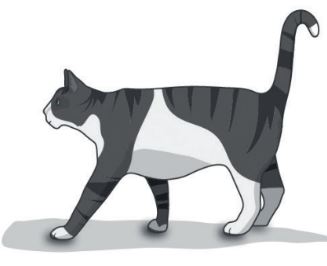How to tell what a cat is thinking
by Ailsa Harvey · 08/08/2020
These sociable animals communicate with each other both verbally and visually, but how can we learn to think cat?

(Image source: Pixabay)
As one of the world’s most popular pets, there are more than 500 million domestic cats living in homes all over the world. People are keen to give their own thoughts on cats, sharing their favourite kitten pictures across the web and welcoming them lovingly into their homes. But have you ever stopped to question what cats think about us? What thoughts take place inside a cat’s head?
According to some animal-behaviour experts, cats might not see as many differences in us as we see in them. Although they see our larger size, this doesn’t make them intimidated. They often approach humans similarly to how they would treat another of their own species. If they continue to view us as fellow cats, they may also expect us to recognise their feelings using the clues other cats would naturally understand.
How can humans begin to think like their pets without the ability to speak with them? Much research has been carried out into the lives and behaviour of felines, both in homes and out in the wild.
A cat’s thoughts continue into sleep, and their dreams involve complex thoughts and long sequences of events. While it took detailed scientific studies to better understand these furry pets, there are simpler ways you can get inside the mind of your feline friend through observation at home – you just have to know what to look for. And it is important for us to be able to process what is going on in our pets heads’ if we are going to look after them.
Ignoring vital signs of stress and discomfort can have significant impacts on the mental health of these animals. Most mammals feel emotions, but the ways in which different species experience and display these varies. Cats are thought to experience happiness, sadness, fear, anger, grief, anxiety and curiosity. While less attached to their owners than dogs, cats are still believed to possess an affection for humans. This is shown in those cats choosing to stay with specific people in their houses, even when they are not being provided with food.
Cats are smarter than we may give them credit for. As we analyse them, they are also taking in our movements and actions. In some households, cats may seem to favour one family member over another. Often this is because they have observed who is more likely to give them a treat. By learning to understand and respect your cat better, you may even win them over as their favourite human.
Telling tails

Content
When calm, a straight vertical tail is a cat’s way of showing it is pleased to see you.

Mocking
If you ever see your cat swaying its upright tail, it is likely showing a derisive attitude towards you or your actions.

Amicable
A tail held out horizontally behind a cat means it isn’t scared or angry. You have caught your cat in a mild, pleasant mood.

Passive aggressive
When your cat sits, thrashing its tail around on the floor, you might not want to aggravate it further as it is probably in an irritable mood.

Submissive
Walking with their tails tucked under their legs, cats are showing compliance. When in confrontation, cats express their capitulation by doing this.

Uncertain
If pointing up at a 45-degree angle, the cat isn’t being threatening but is unsure how it feels about the situation at hand.

Friendly uncertainty
An upright tail with a hooked tip shows uncertainty on the cat’s behalf, but with no signs of aggression.

Defensive
Pointed down with a hooked end, the cat isn’t angry but is ready to strike out if a threat emerges.

Highly angry
The most obvious sign of cat anger, a straight, bristling tail is used by cats as an attempt to appear bigger than they are. If a threat approaches a cat in this state it will retaliate.

Interested
Sitting or lying down indicates that a cat is relaxed, but with its tail tapping the ground, they are also fixated on something happening around them. In this state, cats are deceptively alert.
(Illustrations image credit: Future PLC)
Alerted eyes

(Image source: Pixabay)
Eyes are often a gateway to emotion, and for cats this is no different. The size of a cat’s pupils and the wideness of their eyes at any given time can be used as an indication of inner feelings.
Large pupils on a cat show that they are highly stimulated by their surroundings. Whether they are absorbing signs of threat or excited or surprised by a change in the environment around them, their eyes are usually one of the best giveaways.
Pupils constrict when a cat is angry or fearful. Just before making a swipe at a teasing owner, you will see a cat widen its eyes so that they are large and round, but the pupil will be a small black slit in the centre. Sometimes the eyes aren’t entirely visible, revealing only a sliver of the eye through narrowed eyelids. This is an affectionate sign, and can mean they trust you and are relaxed enough to fall asleep.
This article was originally published in How It Works issue 135, written by Ailsa Harvey
For more science and technology articles, pick up the latest copy of How It Works from all good retailers or from our website now. If you have a tablet or smartphone, you can also download the digital version onto your iOS or Android device. To make sure you never miss an issue of How It Works magazine, subscribe today!





